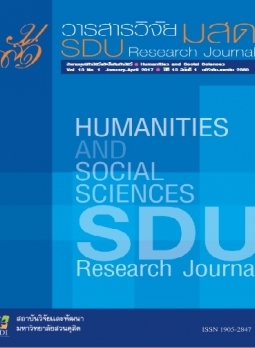เทคนิคการเรียนรู้แบบร่วมมือร่วมใจ เพื่อส่งเสริมการอ่านเพื่อความเข้าใจ สำหรับนักศึกษาไทย
Keywords:
Collaborative Learning Techniques, Reading Comprehension, EFL StudentsAbstract
In accordance with the rapid advancement of education and development of teaching and learning methodologies at the present time, many educators, instructional designers, researchers, and teachers are encouraged to explicitly develop effective and challenging teaching methods which aim to respond to the students’ learning achievement. In these perspectives, collaborative learning techniques are predominantly selected in order to strengthen the students’ academic achievement. Moreover, with multilingual societies, reading as a foreign language continues to take on increasing importance. It has become one of the most important skills to successful learning.
The ability to read helps in strengthening individual learning and provides limitless opportunities for improving the students’ life by acquiring more knowledge from various forms of media such as textbooks, journals, and internet searches in order to achieve personal, occupational, and professional goals. In the last ten years, collaborative learning techniques have been broadly used in foreign language reading classroom since they facilitate positive interdependence, group processing, interaction, high level thinking, and lifelong learning. The purpose of this article is to encourage teachers to apply collaborative learning techniques in the EFL reading classrooms for increasing students’ proficiency in English reading.
References
2Fdocs%2FWhatisCollaborativeLearning.pdf&ei=zLI4VcPSLYPbuQSD3IH4BA&usg= AFQjCNFqz8XYba7wEJ4vy6Wuid9YK4exaA&sig2=OwmHCgiZfesPEMrTTpcwng& bvm=bv.91427555,d.c2E. Swan, M. (1975). Inside Meaning: Proficiency Reading Comprehension. New York, NY: Cambridge University Press. Wallace, C. (1992). Reading. Oxford: Oxford University Press. Wilcox, V. (2008). Collaborative Learning with Adolescents Brings about Social Change for At-risk Freshmen. (Doctoral’s dissertation). USA: Walden University. Woolley, G. (2011). Reading Comprehension: Assisting Children with Learning Difficulties. Retrieved May 30, 2015, from http://www.springer.com/978-94-007-1173-0. Zarai, A. & Gilani, M. (2014). On the Effectiveness of Collaborative Techniques on L2 Reading Comprehension. Journal of Scientific Research and Studies, 1(4), 58-64.








